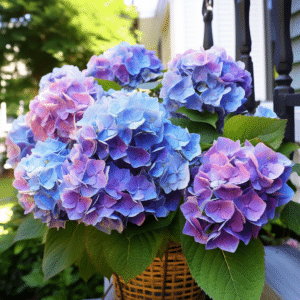Hydrangeas, with their lush foliage and large, showy blooms, are a popular choice for many gardeners. These versatile plants can thrive in a variety of climates and soil types, making them a great addition to any garden. In this guide, we’ll walk you through the process of planting hydrangeas, ensuring your plants get the best possible start.
Understanding Hydrangeas

Before you start planting, it’s important to understand a little about hydrangeas. These plants are native to Asia and the Americas, and there are about 70-75 different species. They’re known for their large flower heads, which can be round, flat, or cone-shaped, depending on the species.
Hydrangeas prefer a slightly acidic soil, with a pH between 5.5 and 6.5. However, they can tolerate a wider range of soil types. What’s interesting about hydrangeas is that the soil pH can actually affect the color of some species. For example, in bigleaf hydrangeas, a more acidic soil will produce blue flowers, while a more alkaline soil will result in pink flowers.
Choosing the Right Hydrangea
There are several types of hydrangeas, each with its own growth habits and care requirements. Some of the most common types include bigleaf hydrangeas, panicle hydrangeas, smooth hydrangeas, and oakleaf hydrangeas. Your choice will depend on your climate, soil, and personal preference.
Bigleaf hydrangeas are the most common type, known for their large, colorful blooms. Panicle hydrangeas are hardy and easy to care for, with large, cone-shaped flower clusters. Smooth hydrangeas have large, round flower heads and are native to the United States. Oakleaf hydrangeas are known for their distinctive, oak-like leaves and cone-shaped flower clusters.
Planting Hydrangeas

Once you’ve chosen your hydrangea, it’s time to start planting. The best time to plant hydrangeas is in the early spring or late fall, when the plant is dormant. However, if you’re planting a potted hydrangea, you can plant it at any time during the growing season.
Start by choosing a location for your hydrangea. These plants prefer a spot with morning sun and afternoon shade, although they can tolerate full sun if they’re kept well-watered. They also need well-draining soil, as they don’t like to sit in water.
Preparing the Soil
Before planting, prepare the soil by removing any weeds or grass and loosening it with a garden fork. If your soil is heavy clay, you may want to amend it with some compost or peat moss to improve drainage.
Next, dig a hole that’s about twice as wide and just as deep as the root ball of your hydrangea. Place the plant in the hole, making sure the top of the root ball is level with the ground. Backfill the hole with soil, firming it gently around the base of the plant.
Watering and Mulching
After planting, water your hydrangea thoroughly. Hydrangeas like a lot of water, especially during the first few years as they’re getting established. However, it’s important not to overwater, as this can lead to root rot.
Once the plant is watered, apply a layer of mulch around the base. This will help conserve moisture, suppress weeds, and regulate soil temperature. Use a natural mulch like wood chips or straw, and avoid piling it up against the stem of the plant.
Caring for Hydrangeas

With the right care, your hydrangeas can thrive and produce stunning blooms year after year. Here are some tips for keeping your hydrangeas healthy and happy.
Pruning
Pruning is an important part of hydrangea care, but it can be a bit tricky. The timing and method of pruning depend on the type of hydrangea you have. Some types, like panicle and smooth hydrangeas, bloom on new wood and should be pruned in late winter or early spring. Others, like bigleaf and oakleaf hydrangeas, bloom on old wood and should be pruned immediately after flowering.
Regardless of the type, when pruning hydrangeas, remove any dead or damaged wood and thin out the plant to improve air circulation. Avoid heavy pruning, as this can reduce flowering.
Fertilizing
Hydrangeas benefit from regular feeding. Apply a slow-release, balanced fertilizer in the spring, following the package instructions. Avoid over-fertilizing, as this can lead to excessive leaf growth at the expense of blooms.
Remember, the pH of your soil can affect the color of your hydrangea flowers. If you want to change the color of your bigleaf hydrangeas, you can add aluminum sulfate to the soil to make it more acidic (for blue flowers) or lime to make it more alkaline (for pink flowers).
Conclusion
Planting and caring for hydrangeas can be a rewarding experience. With their stunning blooms and lush foliage, these plants can add a touch of elegance to any garden. By understanding the needs of your hydrangeas and providing the right care, you can enjoy their beauty for many years to come.
